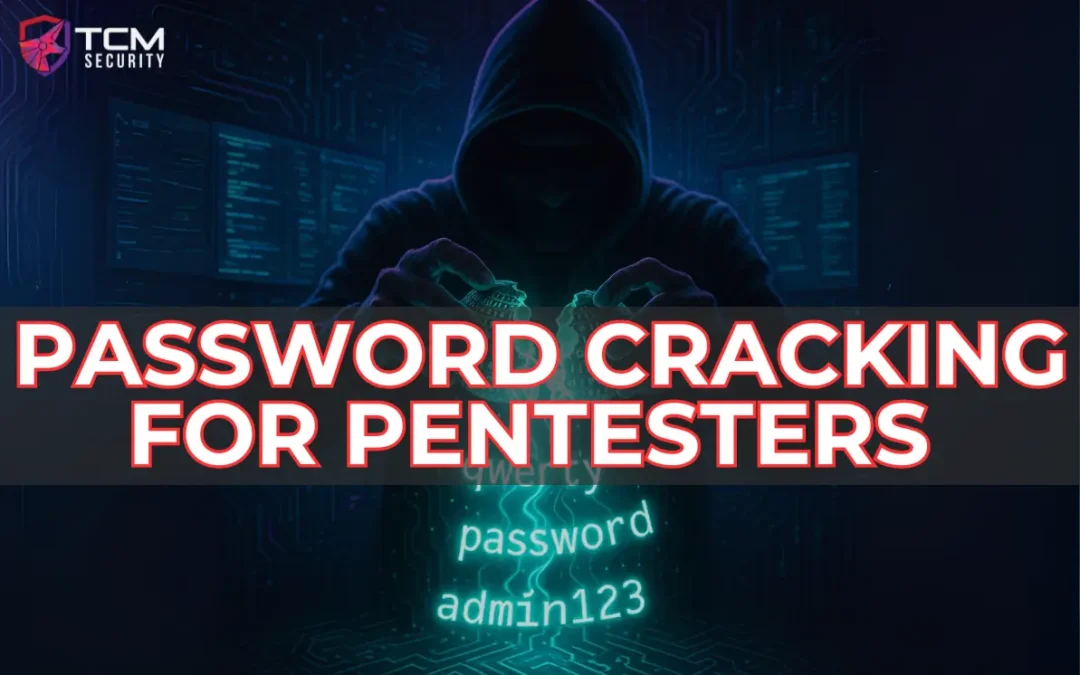What is Password Cracking?
In cyber security, password cracking refers to comparing a list of obtained hashes (algorithmically scrambled passwords) against a ‘dictionary’ (list of hashes of common passwords), finding a match, and thus, the plain text password. A rule can also be applied to the dictionary of passwords, which will use common methods of password modification, such as ‘leet speak’ or number/letter substitutions, and reveal their corresponding hashes.
It can be a race against time for a pentester to translate hashes into usable credentials in order to have more time to invade the target network and explore all of the ways that malicious actors could cause problems. So, knowing an efficient methodology for getting passwords fast can be the difference between discovering useful findings or not during a limited-time engagement.
Factors to Consider
The method you choose will be a factor of time, equipment, and necessity. We will go in order from most efficient quick wins for urgently needed passwords to methods that require more time and resources, but can be much more thorough.
Limited time / Limited equipment / High necessity
If you are under a time crunch and just need any credentials at all for a foothold, then a shorter dictionary and less sophisticated ruleset will likely get you some cracked hashes to work with.
Unlimited time / Advanced equipment / Low necessity
If time is not a factor and you have access to a high-end, up-to-date cracking rig, then running your hashes against larger dictionaries or custom dictionaries modified by more advanced rulesets will net you more cracked hashes.
What Password Cracking Tools to Use
New tools are always being developed and updated in the realm of cyber security, but here are a few tried and true password cracking essentials. These are some of the tools used in real engagements by TCM Security’s own penetration testing team.
Password Cracking Software:
- Hashcat (https://hashcat.net/hashcat/)
Password Dictionaries:
- rockyou.txt
- rockyou2021.txt
Password Rule List:
- OneRuleToRuleThemStill (https://github.com/stealthsploit/OneRuleToRuleThemStill)
Hash Collection
You will also need hashes to crack. Adversary-in-the-Middle attacks, such as ARP Cache Poisoning or LLMNR poisoning, can be used to listen in on network traffic and collect transmitted password hashes. Once you have hashes in hand, you can then begin the process of cracking them and getting to the password inside.
Heath Adams’ 5-Step Password Cracking Methodology for Pentesters
Step 1: Quick Wins
If you are in a bind and just need any password you can find quickly, use rockyou.txt with a ruleset like OneRule. This should take a few minutes to run.
hashcat.exe -m 1000 hashes.txt rockyou.txt -r OneRuleToRuleThemStill.rule -OStep 2: Time To Spare
If you have some breathing room, running a longer wordlist, such as rockyou2021.txt with a ruleset, will deliver more cracked hashes to choose from, but this will also take more time.
hashcat.exe -m 1000 hashes.txt rockyou2021.txt -r OneRuleToRuleThemStill.rule -OStep 3: Digging Deeper
If you have the luxury of time, then there are many strategies to crack hashes that would not be revealed in steps 0 or 1.
Custom Wordlists
An effective strategy is building your own wordlist based on known cracked passwords, computer names, usernames, etc. You can also include words unique to the company by crawling the organization’s website with a tool like CeWL or even using ChatGPT.
hashcat.exe -m 1000 hashes.txt customwordlist.txt -r OneRuleToRuleThemStill.rule -OSophisticated Rulesets
Once you have your word list, you can use other rulesets to modify it. You can use several large rulesets for as many hash possibilities as your list can create. This should not take long with a small word list.
Hash Recycling
Once you crack a new hash, add that word to your list and run it through your rulesets again. Repeat until you get no new hashes.
Step 4: Apply The Mask
Once you’ve exhausted the hash-cracking route, the next step should be a mask attack. If the password policy is 8 characters, you could do the following to brute force all known 8-character passwords:
hashcat.exe -a 3 -m 1000 hashes.txt ?a?a?a?a?a?a?a?a -OLook For Common Patterns
Since you have armed yourself with some known passwords, you might be able to divine a pattern and deduce some aspects of an organization’s password policy, which will help craft a more efficient mask pattern.
Quick wins could be achieved by looking for common traits, such as: a capital letter, six ‘any’ characters, and a special character at the end. The original brute-force pattern listed above would eventually accomplish this, but this more specific pattern would take a fraction of the time (only an hour with higher-end equipment).
hashcat.exe -a 3 -m 1000 hashes.txt ?u?a?a?a?a?a?a?s -Ohashcat.exe -a 3 -m 1000 hashes.txt Welcome?d?d?d?d?s -OStep 5: The Sky Is The Limit
Get creative!
If you haven’t already, you can conduct some OSINT and use your findings in your word list. Scrape a social media profile for unique words. Create a list based on current events or applicable pop-culture references. You can take this methodology as far as time and imagination allow you to create word lists that will crack password hashes.
Thorough OSINT can be a real boost for potential password targets, so if you’re looking for training to learn professional methodology and tactics, the OSINT Fundamentals course will bring you up to speed and the Practical OSINT Research Professional certification will pit your skills against a simulated Intelligence gathering exam complete with a report of findings that will be professionally reviewed.
Conclusion
Credentials are the lifeblood of a pentest. The more accounts you can collect and unlock through cracked password hashes, the higher your chances of finding an efficient key to the system you are trying to compromise. In large organizations with a lax password policy, quickly harvesting the low-hanging fruit can yield more time for lateral movement and privilege escalation, leaving your clients better informed on how to defend their network.
For more information on password cracking tactics and methods, check out the Practical Ethical Hacking course. If you are looking to demonstrate these abilities through certification, the Practical Junior Penetration Tester and Practical Network Penetration Tester combine these skills with others necessary for a well-rounded pentester.
About the Author: Josh Daniels
Josh is an avid storyteller and writer who loves learning about the behind-the-scenes of the digital world we live in. While his professional experience is in content marketing, Josh began pursuing a career in cybersecurity in 2022, gaining a Sec+ certificate along with other training from industry professionals and a life long learner attitude.
When he is not writing, Josh enjoys outdoor adventures with his family, watching movies, reading, and an unofficial (unpaid) side gig as a Game Master Consultant for several friends who play table top RPGs. At TCM, Josh has found a home where his passion for storytelling and cybersecurity meet.
“Once men turned their thinking over to machines in the hope that this would set them free. But that only permitted other men with machines to enslave them.”
– Frank Herbert
About TCM Security
TCM Security is a veteran-owned, cybersecurity services and education company founded in Charlotte, NC. Our services division has the mission of protecting people, sensitive data, and systems. With decades of combined experience, thousands of hours of practice, and core values from our time in service, we use our skill set to secure your environment. The TCM Security Academy is an educational platform dedicated to providing affordable, top-notch cybersecurity training to our individual students and corporate clients including both self-paced and instructor-led online courses as well as custom training solutions. We also provide several vendor-agnostic, practical hands-on certification exams to ensure proven job-ready skills to prospective employers. Pentest Services: https://tcm-sec.com/our-services/ Follow Us: Email List | LinkedIn | YouTube | Twitter | Facebook | Instagram | TikTok
Contact Us: [email protected]
See How We Can Secure Your Assets
Let’s talk about how TCM Security can solve your cybersecurity needs. Give us a call, send us an e-mail, or fill out the contact form below to get started.

